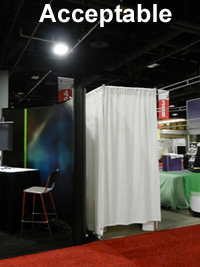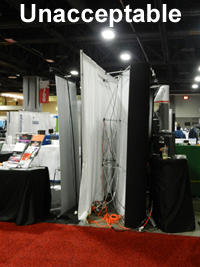Booth Information
Non-Contracted Exhibit Space
Any person, firm, or organization not having contracted with the Society for the occupancy of space in the exhibit hall will not be permitted to display or demonstrate any products, processes, or services; solicit orders; or distribute advertising materials in the San Diego Convention Center or in any hotel used by the Society to house registrants. Any noncompliance with this regulation will result in the prompt removal of the offending person and property from the area. No exhibit will be permitted in a hotel room.
Americans with Disabilities Act
Exhibitors shall be responsible for compliance with the Americans with Disabilities Act of 1992 with regard to their exhibit space, including, but not limited to wheelchair access. Further information regarding ADA compliance is available via phone at (800) 514-0301.
Booth Layouts
Each 10’ x 10’ exhibit space will have 8’ high white back drape and 36” gold side rail defining the confines of the space, blue aisle carpet will be provided in the exhibit hall. Exhibitors must provide carpeting in their exhibit space. A booth identification sign measuring 7” x 44” and showing only the company name will also be supplied in all linear booths.
Standard Booths
All display material is restricted to a maximum height of 48” except for the back wall of the display, which is limited to 8’ in height. The booth height may be maintained up to 50 percent of the distance from the back wall toward the front of the space. No obstructions in the front half of the booth above the height of 48” will be permitted. Models or schematic drawings of cubic content exhibits should be submitted in advance to Exhibit Management for approval. No exhibit may span an aisle by roofing or floor covering.
* Exposed unfinished sides of exhibit backgrounds must be draped to present an attractive appearance. If such draping is not ordered, the decorator, with the approval of Exhibit Management, will install draping and charge the exhibitor.
Island Booths
In island booth units (units bound on four sides by aisles), the full cubic content of the space may be used; however, all display material is restricted to 16’ in height. Sufficient see-through areas must be provided so as not to block the view of the adjacent exhibits. Models or schematic drawings of cubic content exhibits should be submitted in advance to Exhibit Management for approval no later than August 24.
Companies with island booths are permitted to hang a sign over their booth. Sign height limit is 20 feet.
Nothing shall be posted, tacked, nailed, or otherwise attached to the walls, floors, or other parts of the exhibit facility or furniture contained in the facility.
Peninsula Booths
With peninsula booth units, the peninsula should not cause a visual disadvantage to the adjacent exhibits that is greater than would be caused by an in-line booth in the immediately adjacent space. Inline booth restrictions apply to the 10’ portion of the exhibit that borders on another exhibitor’s booth; island specifications and restrictions apply to the remaining portion of the peninsula booth. Models or schematic drawings of cubic content of exhibits should be submitted in advance to Exhibit Management for approval no later than August 24.
End-Cap Booths
End-cap booths (see below) are not permitted. An end-cap booth is defined as a booth exposed to aisles on three sides and consisting of two booths. End-cap Booths are 10ft. deep by 20ft. wide. The maximum back wall height of 8ft. is allowed only in the back half of the booth space and within 5ft. of the two sides, with a 4ft. height restriction imposed on all materials remaining in the remaining space forward to the aisle.
Signs
Only companies with island booths are permitted to hang a sign over booth. Sign height limit is 20 feet.
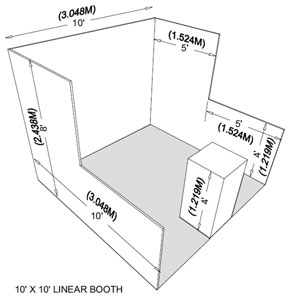
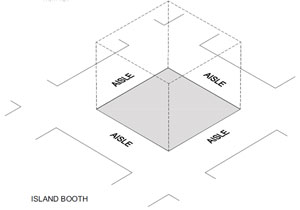
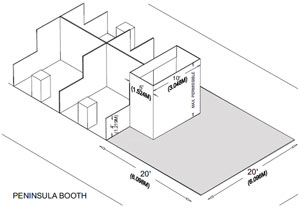
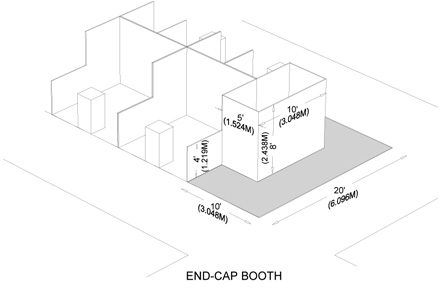
Exposed unfinished side of exhibit backgrounds must be draped to present an attractive appearance. If such draping is not ordered, the decorator, with approval of Exhibit Management, will install draping and charge the exhibitor. See below for examples of acceptable and unacceptable exhibit backgrounds.
